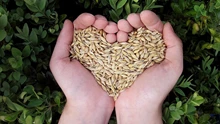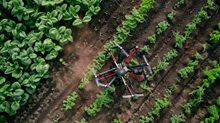
The commercial method of propagation of mango in India is Inarching, which is cumbersome, requires much skill, involves high cost and the percentage of success is not high. Some other methods have been recommended to replace this method but the nurserymen are not much inclined to adopt those as they are apt to carry out this method since long past. In the present article, an improved method of Inarching has been presented which is easy to perform, involves less cost, and may have acceptability to the nurserymen.
In the horticultural nurseries in most parts of India, the mango tree is conventionally propagated by the Inarching method of grafting. This method, belonging to the method of Approach Grafting is, however, confronted with a number of difficulties. Some of these are, the technique is cumbersome and requires much skill to perform, the percentage of success is low even when done with great care and much time is required by the graft to become ready for planting in the orchard which is actually three years from the start.
Apart from these, another great difficulty lies in the fact that a durable podium, i.e., thatched roofing with bamboo poles and strips becomes necessary to be built up for maintaining the potted rootstock plants over that for the purpose of carrying out the grafting operation.

Erection of this thatched roofing becomes necessary as the scion shoots are needed to be used for grafting, i.e., having similar maturity and thickness because those of the rootstock shoots are borne at the extremity of the top branches of the scion tree. Besides this, after the grafting operation is done, it becomes necessary to climb up the thatched roof with the help of a ladder in order to irrigate and take care of the potted plants that have been grafted. These operations are necessary to be done regularly until the grafts are detached from the scion tree and brought down from the roof. Evidently, all the above steps involve high labor costs and eventuate high cost of the grafts.
To get rid of these hazards, a number of superior methods of grafting, viz., Veneer grafting, Forkert budding, modified Forkert budding, Chip budding and Stone (Epicotyl) grafting have been recommended by the horticultural scientists in India to replace Inarching.
Nevertheless, the nurserymen in most parts of India are not inclined to give up the method and their argument is , although Inarching is a cumbersome method, it is difficult to replace it as it is an age-old practice and the malees (= grafters) are highly accustomed to the method. Hence, instead of replacing the method of Inarching completely, any attempt to eradicate its hazards and thereby, making the method simplified should be a practical line of approachThe present article has taken into account this fact and has devised a method which has aimed at simplifying the Inarching method of grafting and this is described in the following. The method essentially consists of artificially forcing the scion tree of mango to creep it up on the ground such that construction of thatched roofing which is the greatest hazard could be eliminated.
Apparently, mango being an erect growing tree, its trunk grows vertically upwards. But by artificial manipulation, it is possible to make the tree crawling on the ground instead of allowing it to grow vertically upward. This can be performed manually , adopting simple technique and without use of any chemical. The entire process is delineated below.
At first, a sufficiently strong grafted mango plant of the desired variety which is to be used as the scion tree is planted on the nursery ground. The ground should be spacious and should not have vegetation, building etc. within a radius of 6 – 9 metres. It is essential that the grafted mango tree which is to be used as the scion should grow vigorously after it is planted. Hence, the site of its planting should be made enriched.

To make so, during summer season, a pit of 50 – 60 cm depth and 70 – 80 cm width should be made and the soil dug up from the pit should be weathered. Accordingly, as shown in Figure – 2 , the soil dug up from the upper part of the pit is heaped on the ground at one side of the pit. Then the soil dug up from the lower part of the pit is heaped on the ground at the other side of it. On exposure to scorching heat of summer for a month, insect eggs, larvae etc., if any present in the dug up soil will get destroyed. Then, just before rainy-season, the soil
dug up respectively from the upper part and the lower part of the pit should be separately mixed with 15 – 20 kg of farmyard manure , 0.75 – 1 kg of superphosphate, 0.15 kg of muriate of potash along with a a little quantity of neem cake or 5 percent Aldrin.
The pit should then be filled with the soil-manure mixture. Before filling, the side wall of the pit should be scraped with a khurpi to loosen the hard crust formed. Filling of the pit should be done in such a manner that the soil dug up from upper part of the pit is placed at the lower part of it and over that, dug up soil from the lower part be placed.

After filling, the pit should be watered for few days to settle the soil and if any depression is noticed, it should be made up with soil-manure mixture. An important aspect to be noted is.

the grafted scion plant should be planted in a slightly slanting position, such that its trunk maintains a 450 – 600 angle from the ground level and not in a vertically straight manner. After few months of growth of the plant, a 1 – 3 metre long strong rope should be taken and one end of it should be tied near the tip of the plant. The other end of the rope should be tied with a 6 – 10 cm long iron hook. Then the rope is slightly pulled downwards along the tilted side of the plant and in this tightened position, the hook tied to the other end is firmly infixed, i.e., pegged to the ground.

the malee (grafter) would sit comfortably on a low-heighted stool and carry out the operation. Thus, the necessity of erecting thatched roof to do the grafting would not be necessary in this method. When required number of the rootstock plants have been Inarch-grafted, the upright shoots of the scion tree that were not used should be forced to bend like above. After several years, the crawled mango tree will have such an appearance that anybody who does not know what has happened there, may think that somebody has cut off a mature mango tree at its base and has befelled the tree on the ground. Such a crept mango tree may although produce some flowers but fruits do not develop from them. (Some economically important plants like pineapple, pulses etc. may however, be grown there).
It should not be forgotten that creeping of a mango tree is not its inherited character. In fact, it can be done only artificially by forcing it. Thus, whenever the bending force is not applied, the shoots will again tend to grow vertically upwards. Hence, bending of shoots should be done regularly as long as the tree will be used to obtain scion shoots from it. Also that the crept tree should be regularly applied with manure, fertilizers, irrigation etc, so that large number of scion shoots are produced.
Dr. Bibhas Chandra Manumdar
M.SC Agri, PH.D
Prtofessor in Horticulture institute of Agriculture Sciences
Calcutta University
Kolkata, West Bengal – 700029
Mob- 09830272846
Email.- profbcmazumdar@yahoo.com














Share your comments